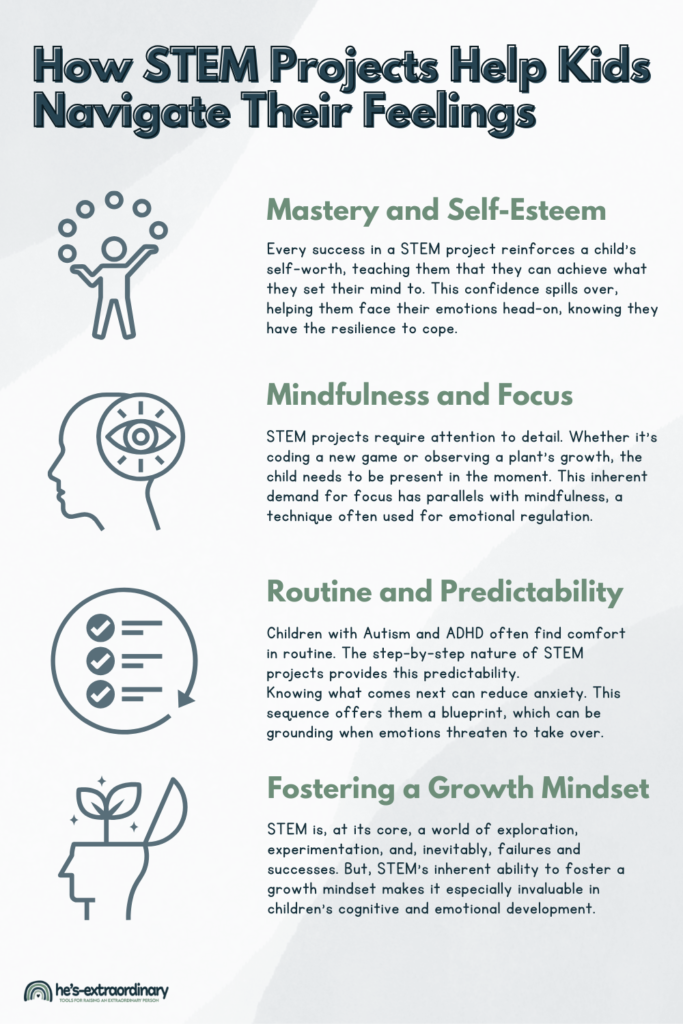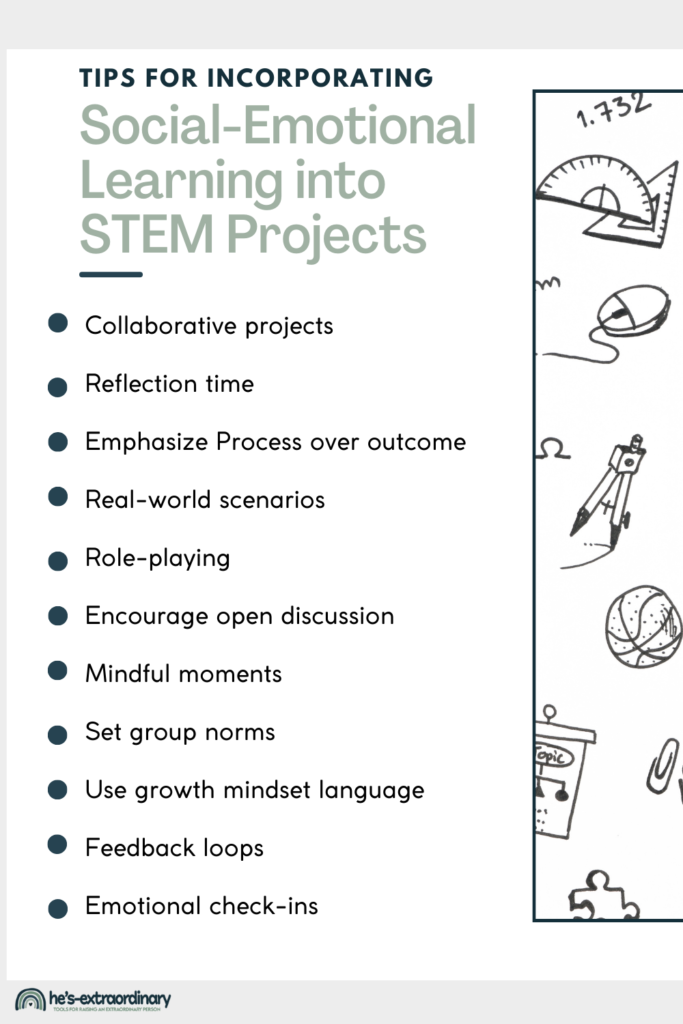Emotion Regulation and Science: How STEM Projects Help Kids Navigate Their Feelings
What’s inside this article: A look at how parents and educators can use STEM projects to help kids learn emotional self-regulation and foster a growth mindset. Includes tips for incorporating social-emotional learning into STEM.
Disclaimer: This post contains affiliate links.
Emotions can be tricky, even for adults. For children, especially those with Autism and ADHD, they can be highly challenging – vast, unpredictable, and overwhelming. We’re always looking for new ways to help kids understand and cope with their emotions.
In the quest for tools and techniques to navigate emotions, you might not immediately think of STEM (Science, Technology, Engineering, Mathematics). However, the methodical world of STEM offers surprising therapeutic benefits for emotion regulation.
Let’s dive into how engaging in STEM projects can be a beacon of light for kids trying to understand and manage their emotions.
The Emotion-STEM Connection: A Brief Overview
At first glance, emotions and STEM might seem like they occupy different universes. But beneath the surface, there’s a profound connection. STEM projects, with their structured approach, offer predictability.
This predictability can be a soothing counter to the tumultuous world of emotions that some kids with Autism or ADHD experience.
These children can anchor themselves by focusing on a STEM task, diverting their attention from overwhelming feelings to a constructive activity.
Mastery and Self-Esteem
Achieving a goal, like completing a math problem or building a working model, brings a sense of accomplishment. For kids with ADHD or autism, who often struggle with self-esteem due to challenges in traditional academic settings, these victories are monumental.
Every success in a STEM project reinforces their self-worth, teaching them that they can achieve what they set their mind to. This confidence spills over, helping them face their emotions head-on, knowing they have the resilience to cope.
Mindfulness and Focus
STEM projects require attention to detail. Whether it’s coding a new game or observing a plant’s growth, the child needs to be present in the moment. This inherent demand for focus has parallels with mindfulness, a technique often used for emotional regulation.
By concentrating on the task and the present moment, children can distance themselves from distressing emotions, allowing them to process feelings without becoming overwhelmed.
Practicing being present for STEM projects can help make it easier for them to practice mindfulness for self-regulation – like using visualization or grounding techniques when they’re upset.
Routine and Predictability
Children with Autism and ADHD often find comfort in routine. The step-by-step nature of STEM projects provides this predictability.
Knowing what comes next can reduce anxiety. For instance, if a child is conducting a science experiment, they know that after mixing two chemicals, they need to observe the reaction.
This sequence offers them a blueprint, which can be grounding when emotions threaten to take over.
Foster a Growth Mindset through STEM
STEM is, at its core, a world of exploration, experimentation, and, inevitably, failures and successes. But, STEM’s inherent ability to foster a growth mindset makes it especially invaluable in children’s cognitive and emotional development.
You can use STEM projects to help kids with autism and ADHD develop a growth mindset by:
- Embracing mistakes as learning opportunities
- Celebrating the process
- Promoting curiosity and open-mindedness
- Setting incremental challenges – work on more challenging projects or experiments as your child progresses
- Encouraging collaborative problem-solving

The Social Aspect of STEM
While STEM projects can be solitary, they also offer numerous opportunities for collaboration. This makes STEM great for helping kids build social skills.
Group projects are an excellent opportunity for children to bond over shared interests. These interactions allow kids to practice and refine their social-emotional skills.
For instance, celebrating a teammate’s success can teach joy, while resolving a conflict over a project’s direction can be a lesson in managing frustration or disappointment.
MEL Science
Embarking on the journey of integrating STEM with social-emotional learning might initially seem challenging. But what if there was a solution that made it not only effortless but also incredibly engaging? Enter MEL Science STEM kits.
MEL Science has carved a niche in providing some of the most intriguing and well-thought-out STEM kits available. These kits are tailored to spark curiosity while also being ripe with opportunities for social-emotional learning.
Tips for Incorporating Social-Emotional Learning into STEM Projects
For parents and educators keen to harness the power of STEM for social-emotional learning, here are a few pointers:
- Collaborative Projects: Introduce group projects or team challenges. Collaboration naturally fosters communication, empathy, and understanding, teaching kids to value and respect different perspectives.
- Reflection Time: After a STEM activity, create a dedicated time for kids to discuss their feelings and experiences during the project. This helps them recognize, understand, and communicate their emotions.
- Emphasize Process Over Outcome: Praise effort, persistence, and problem-solving strategies rather than just the end result. This nurtures resilience and the understanding that mistakes and failures are learning opportunities.
- Role-playing: Introduce role-playing elements into STEM projects. For example, let one child be the project manager while another is the technician. Switching roles can foster empathy and understanding of diverse viewpoints.
- Incorporate Real-world Scenarios: Design projects that address real-world issues, like climate change or community challenges. This fosters a sense of purpose and teaches kids about societal empathy and impact.
- Encourage Open Discussion: Create an environment where kids feel safe sharing their ideas, worries, and successes. This promotes active listening and effective communication.
- Mindfulness Moments: Incorporate short mindfulness or relaxation breaks, especially during complex tasks. This can help kids manage stress, stay present, and develop self-awareness.
- Set Group Norms: At the beginning of group activities, let kids set ‘group norms’ or rules for collaboration. This encourages ownership of behavior and promotes a mutual respect culture.
- Growth Mindset Language: Use and encourage language that promotes a growth mindset, like “Let’s learn from this” or “We can improve by…”. This helps kids view challenges as opportunities for growth.
- Feedback Loops: Incorporate regular feedback sessions where kids can give and receive constructive feedback. This teaches them the value of feedback, improves self-awareness, and hones interpersonal skills.
- Emotional Check-ins: Especially for longer projects, have regular emotional check-ins, asking kids how they feel or what they find challenging. This promotes emotional self-awareness and the ability to seek help when needed.

Remember
Emotions are complex, and there’s no one-size-fits-all approach to navigating them. However, the structured, engaging, and therapeutic world of STEM offers a unique toolkit for children, especially those with Autism and ADHD, to explore and manage their feelings.
By intertwining emotional learning with STEM projects, we can equip our children with the skills to understand the world around them and the intricate world within them.

